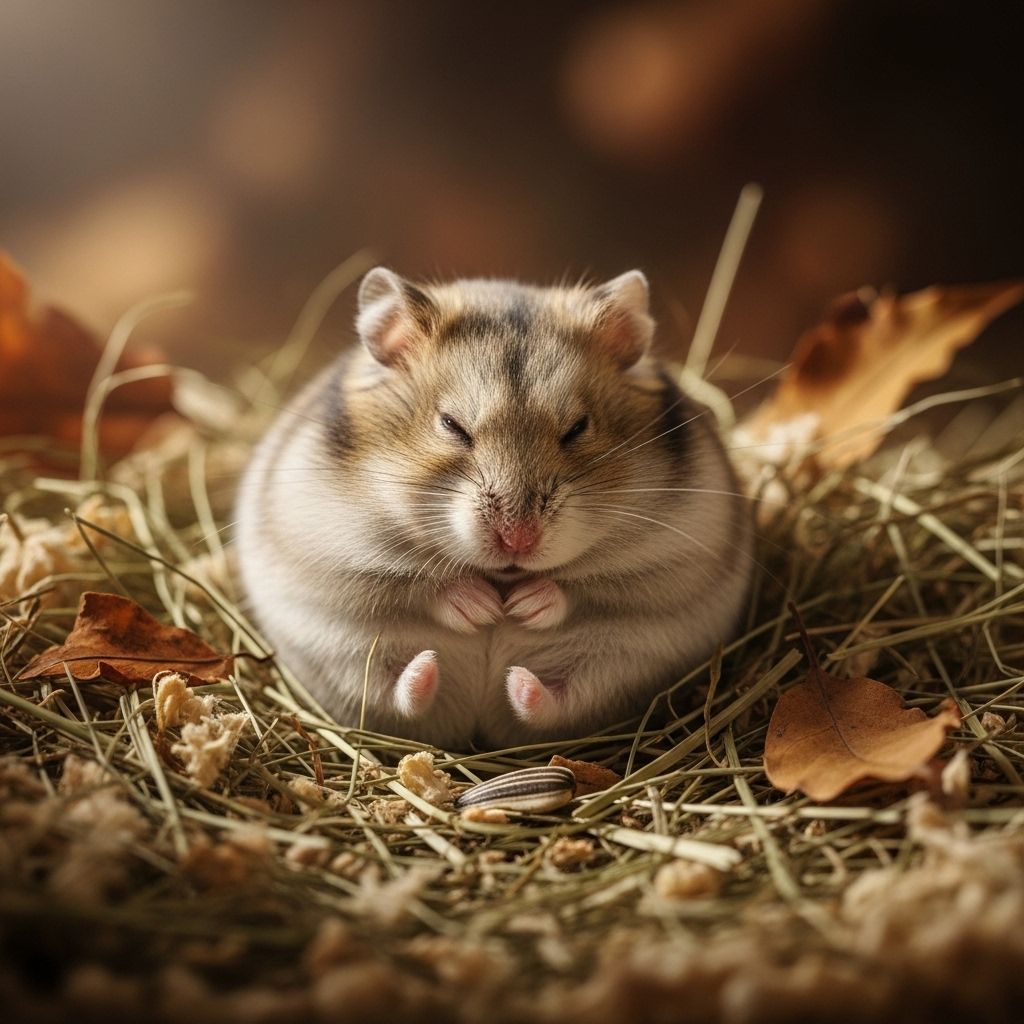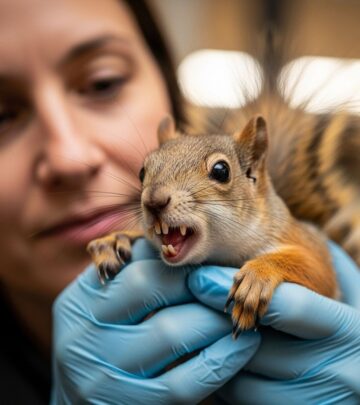Do Hamsters Hibernate? Understanding Hamster Hibernation and Torpor
A warm, well-lit habitat helps guard your tiny companion against cold-induced torpor.

Image: HearthJunction Design Team
Do Hamsters Hibernate?
Many pet owners wonder if their hamsters hibernate, especially as the seasons change. The answer is more nuanced than a simple yes or no: while wild hamsters can hibernate, pet hamsters rarely do. Instead, pet hamsters may enter a temporary state known as torpor, which helps them cope with cold conditions or other environmental stresses. Understanding the difference between true hibernation and torpor—and learning how to recognize the signs—can help you keep your hamster healthy and safe all year round.
What is Hibernation?
Hibernation is a natural physiological state many animals enter to survive harsh winter climates. During true hibernation, an animal’s metabolism slows dramatically, body temperature drops, breathing becomes shallow, and heart rate slows. This state uses minimal energy and can last for weeks or even months. Wild European hamsters are true hibernators, but most pet hamsters, like Syrian and dwarf hamsters, do not regularly experience this.
Torpor vs. Hibernation: What’s the Difference?
Torpor is sometimes confused with hibernation, but they are not the same. Torpor is a temporary, short-term state of reduced physiological activity, often lasting hours or a few days. Hibernation is an extended torpid period, reserved for truly wild species or specific situations.
Key differences:
- Duration: Torpor lasts hours to days; hibernation lasts weeks or months.
- Cause: Torpor occurs in response to short-term cold, lack of food, or low daylight. Hibernation is an adaptation for seasonal survival.
- Species: Most domestic hamsters only enter torpor. Wild species, such as the European hamster, undergo true hibernation.
Table: Hibernation vs. Torpor in Hamsters
| Feature | Hibernation | Torpor |
|---|---|---|
| Duration | Weeks to months | Hours to a few days |
| Triggered By | Seasonal changes (cold, less daylight, food scarcity) | Sudden cold, low food, abrupt environmental change |
| Species | Wild, like European hamsters | Most domestic hamsters |
| Signs | Slow response, very low temperature | Very low activity, but shorter duration |
Which Hamster Species Hibernate?
Whether a hamster will hibernate depends on its species:
- European hamsters: True hibernators in the wild, entering deep, seasonal hibernation in response to cold and lack of daylight.
- Syrian (Golden) hamsters: May hibernate in prolonged, extreme conditions, but in domestic environments, they typically only experience torpor.
A gene helps Syrian hamsters endure cold by limiting cellular damage, as some studies suggest. - Dwarf hamsters (Roborovski, Campbell’s, Russian, Winter White): Rarely hibernate; can enter torpor if stressed by cold or lack of food.
Why Do Hamsters Enter Torpor?
Pet hamsters most commonly experience torpor, not true hibernation, due to:
- Cold temperatures: If a hamster’s environment falls below 65°F (18°C), torpor may be triggered to conserve energy.
- Lack of food: Limited food availability signals to the hamster’s body to conserve resources.
- Decreased daylight: Shorter days may prompt adaptive behavior to survive changing conditions.
- Sudden environmental changes: Sharp drops in temperature or changes in habitat can provoke a survival response.
How Long Can Hamsters Hibernate?
True hibernation in wild European hamsters can last weeks or months. Pet hamsters, however, experience torpor for much shorter durations:
- Torpor typically lasts: Several hours to a few days, usually no longer than 3–4 days in a domestic setting.
- Once normal conditions return (warmer environment, food present), hamsters should gradually wake and resume activity.
- There are rare cases where torpor can last longer if conditions do not improve.
Signs Your Hamster May Be in Torpor or Hibernation
Knowing the signs of torpor or hibernation is essential, as these can resemble serious illness or even death. Watch for:
- Slowed breathing or very shallow breaths
- Low heart rate: The hamster may feel cold to the touch
- Low body temperature: The hamster’s body may be almost as cold as its environment
- Unresponsive: Lethargic and not waking easily, even when gently handled
- Limp or curled body posture
If you suspect your hamster is in torpor, check for subtle signs of life, such as whisker twitching or shallow breathing. Always err on the side of caution and consult a veterinarian.
Risks & Dangers of Torpor for Pet Hamsters
Torpor is risky for domestic hamsters. While it is a natural coping mechanism, it can be fatal if:
- The hamster is in torpor for too long
- The temperature remains low or drops further
- The hamster is young, elderly, sick, or underweight
Prolonged torpor can cause dehydration, organ failure, and sometimes death if the animal is not revived appropriately.
How to Prevent Your Hamster from Entering Torpor
Keeping your hamster comfortable and healthy is key to preventing dangerous torpor episodes. Use these tips:
- Keep the habitat warm: Maintain a temperature between 65°F and 75°F (18–24°C).
- Avoid drafts and sudden cold: Place the cage away from windows, air conditioners, and direct contact with cold surfaces.
- Provide plenty of bedding: Extra bedding helps your hamster self-regulate its temperature.
- Ensure consistent food and water: Replenish food daily; always provide access to clean water.
- Use artificial lighting: In winter, consider adding a lamp to extend daylight hours (mimic 12–14 hours of light).
- Monitor for signs: If your hamster becomes lethargic or less responsive, act promptly.
What To Do If Your Hamster Enters Torpor
If you find your hamster unresponsive, cool to the touch, or showing other torpor signs:
- Move to a warm room: Gently transfer the cage to an area at 70°F–75°F (21–24°C).
- Warm the hamster gradually: Place a warm (not hot) water bottle wrapped in a t-shirt or towel near the hamster. Never apply heat directly.
- Monitor breathing and movement: Shallow breaths or tiny whisker twitches signal torpor rather than death.
- Offer food and water: Provide easy access, but do not force feed.
- Do not shake or handle roughly: Rough handling can cause injury or shock.
- Consult a veterinarian immediately: Especially if your hamster does not respond to warming within an hour or shows signs of distress.
The Science Behind Hamster Survival in Cold
Recent research reveals that some hamster species, like the Syrian hamster, possess a special gene that helps their cells survive during extreme cold. This gene limits the buildup of damaging free radicals, allowing hibernators to withstand dangerously low body temperatures without cellular damage. While this adaptation is essential in wild settings, pet hamsters rely on their human caregivers to avoid threats posed by low household temperatures.
Common Myths About Hamster Hibernation
- Myth: All hamsters hibernate.
Fact: Only certain wild species truly hibernate; most pet hamsters do not. - Myth: A motionless hamster is always dead.
Fact: Torpid hamsters can appear lifeless but are very much alive. - Myth: Hibernation is always safe.
Fact: Torpor in pets can be life-threatening if not addressed quickly.
Frequently Asked Questions (FAQs)
Do pet hamsters hibernate in winter?
Most pet hamsters do not experience true hibernation. However, sudden cold or stress can push them into torpor, which mimics many hibernation behaviors but is much shorter and riskier in a domestic setting.
How can I tell if my hamster is dead or in torpor?
Look for subtle signs like shallow breathing, twitching whiskers, or a limp (but not stiff) body. Always consult a veterinarian if you are unsure, as delays can be dangerous if the hamster is alive and needs help.
What temperature is too cold for a hamster?
Any sustained temperature below 65°F (18°C) can trigger torpor in pet hamsters. Always keep the enclosure above this threshold in colder months.
Can hamsters recover from torpor or hibernation?
Yes, if intervention happens quickly. Slow, gentle warming is essential, and once conditions return to normal, most hamsters revive within an hour. If recovery is not almost immediate, veterinary attention is critical.
Are there health risks to repeated torpor episodes?
Yes. Repeated or prolonged torpor can weaken the immune system, cause dehydration, and increase the risk of organ failure in pet hamsters.
Conclusion: Hamster Hibernation Isn’t for Pets
In summary, while wild hamsters may hibernate, almost all pet hamsters never need to. Torpor can be a dangerous, last-resort survival response to environmental stressors, not a normal part of their life cycle in your home. The best way to keep your hamster healthy and safe is to maintain a warm, stable environment, watch for warning signs, and seek veterinary advice at the first suspicion of torpor. With proper care, your tiny companion can thrive—alert, active, and cozy—all year long.
References
- https://www.chewy.com/education/small-pet/hamster/do-hamsters-hibernate
- https://pmc.ncbi.nlm.nih.gov/articles/PMC4852639/
- https://www.sciencedaily.com/releases/2024/09/240930212900.htm
- https://www.petmd.com/exotic/do-hamsters-hibernate
- https://cosmosmagazine.com/science/biology/hibernating-hamsters-dont-feel-the-cold/
Read full bio of Anjali Sayee












